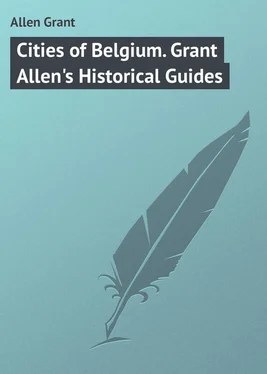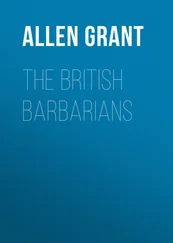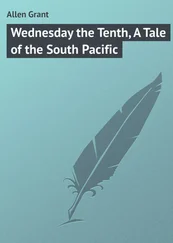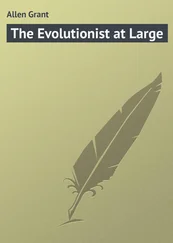Grant Allen - Cities of Belgium. Grant Allen's Historical Guides
Здесь есть возможность читать онлайн «Grant Allen - Cities of Belgium. Grant Allen's Historical Guides» — ознакомительный отрывок электронной книги совершенно бесплатно, а после прочтения отрывка купить полную версию. В некоторых случаях можно слушать аудио, скачать через торрент в формате fb2 и присутствует краткое содержание. ISBN: , Издательство: Иностранный паблик, Жанр: foreign_language, foreign_prose, на английском языке. Описание произведения, (предисловие) а так же отзывы посетителей доступны на портале библиотеки ЛибКат.
- Название:Cities of Belgium. Grant Allen's Historical Guides
- Автор:
- Издательство:Иностранный паблик
- Жанр:
- Год:неизвестен
- ISBN:http://www.gutenberg.org/ebooks/49690
- Рейтинг книги:3 / 5. Голосов: 1
-
Избранное:Добавить в избранное
- Отзывы:
-
Ваша оценка:
- 60
- 1
- 2
- 3
- 4
- 5
Cities of Belgium. Grant Allen's Historical Guides: краткое содержание, описание и аннотация
Предлагаем к чтению аннотацию, описание, краткое содержание или предисловие (зависит от того, что написал сам автор книги «Cities of Belgium. Grant Allen's Historical Guides»). Если вы не нашли необходимую информацию о книге — напишите в комментариях, мы постараемся отыскать её.
Cities of Belgium. Grant Allen's Historical Guides — читать онлайн ознакомительный отрывок
Ниже представлен текст книги, разбитый по страницам. Система сохранения места последней прочитанной страницы, позволяет с удобством читать онлайн бесплатно книгу «Cities of Belgium. Grant Allen's Historical Guides», без необходимости каждый раз заново искать на чём Вы остановились. Поставьте закладку, и сможете в любой момент перейти на страницу, на которой закончили чтение.
Интервал:
Закладка:
The somewhat lower building, to the right of the Hôtel de Ville, is the **Chapelle du Saint Sang. The decorated portal round the corner also forms part of the same building.
[In the 12th and 13th centuries (age of the Crusades) the chivalrous and credulous knights of the North and West who repaired to the Holy Land, whether as pilgrims or as soldiers of the Faith, were anxious to bring back with them relics of the saints or of still more holy personages. The astute Greeks and Syrians with whom they had to deal rose to the occasion, and sold the simple Westerns various sacred objects of more or less doubtful authenticity at fabulous prices. Over these treasured deposits stately churches were often raised; for example, St. Louis of France constructed the Sainte Chapelle in Paris, to contain the Crown of Thorns and part of the True Cross, which he had purchased at an immense cost from Baldwin, Emperor of Constantinople. Among the earlier visitors to the Holy Land who thus signalised their journey was Theodoric of Alsace, elected Count of Flanders in 1128; he brought back with him in 1149 some drops of the Holy Bloodof the Saviour, said to have been preserved by Joseph of Arimathea, which he presented to his faithful city of Bruges. Fitly to enshrine them, Theodoric erected a chapel in the succeeding year, 1150; and this early church forms the lower floor of the existing building. Above it, in the 15th century, when Bruges grew richer, was raised a second and more gorgeous chapel (as at the Sainte Chapelle), in which the holy relic is now preserved. Almost all the works of art in the dainty little oratory accordingly bear special reference to the Holy Blood, its preservation, and its transport to Bruges. The dedication is to St. Basil, the founder of eastern monasticism – a Greek Father little known in the West, whose fame Theodoric must have learned in Syria. The nobles of Flanders, it must be remembered, were particularly active in organising the Crusades.]
The exteriorhas a fine figure of St. Leonard (holding the fetters which are his symbol) under a Gothic niche. He was the patron of Christian slaves held in duress by the Saracens. The beautiful flamboyant portaland staircase, round the corner, erected in 1529-1533, in the ornate decorative style of the period, have (restored) figures of Crusaders and their Queens in niches, with incongruous Renaissance busts below.
To visit the interior, ring the bell in the corner: admission, 50 c. per person.
The Museumof the Brotherhood of the Holy Blood, on the first floor, which we first visit, contains by the left wallthe handsome silver-gilt Reliquary (of 1617), studded with jewels, which encloses the drops of the Holy Blood. The figures on it represent Christ (the source of the Blood), the Blessed Virgin, St. Basil (patron of the church), and St. Donatian (patron of the town). The Blood is exhibited in a simpler châsse in the chapel every Friday; that is to say, on the day of the Crucifixion. The great Reliquary itself is carried in procession only, on the Monday after the 3rd of May. Right and left of the châsse are portraits of the members of the Confraternity of the Holy Blood by P. Pourbus, 1556: unusually good works of this painter. A triptych to the right, by an unknown master of the early 16th century, figures the Crucifixion, with special reference to the Holy Blood, representing St. Longinus in the act of piercing the side of Christ (thus drawing the Blood), with the Holy Women and St. John in attendance; on the wings, the Way to Calvary, and the Resurrection.
Between the windowsis a curious chronological picture of the late 15th century, representing the History of Our Lady in the usual stages, with other episodes. To the R. of it, a painting of the 15th century shows Count Theodoric receiving the Holy Blood from his brother-in-law, Baldwin, King of Jerusalem, and the bringing of the Holy Blood to Bruges.
On the right wallthere is a famous *triptychby Gerard David (the finest work here), representing the Deposition in the Tomb, with the Maries, St. John, Nicodemus, and an attendant holding a dish to contain the Holy Blood, which is also seen conspicuously flowing from the wounds; the left wing shows the Magdalen with Cleophas; the right wing, the preservation of the Crown of Thorns by Joseph of Arimathea. The portrait character of the faces is admirable: stand long and study this fine work.
The original designs for the windows of the Chapel are preserved in a glass caseby the window; behind which are fragments of early coloured glass; conspicuous among them, St. Barbara with her tower.
On the exit wallis a fine piece of late Flemish tapestry, representing the bringing of the body of St. Augustine to Pavia, with side figures of San Frediano of Lucca and Sant’ Ercolano of Perugia – executed, no doubt, for an Italian patron.
The Chapelitself, which we next enter, is gorgeously decorated in polychrome, recently restored. The stained glass windows, containing portraits of the Burgundian Princes from the beginning of the dynasty down to Maria Theresa and Francis I., were executed in 1845 from earlier designs. The large window facing the High Altar is modern. It represents appropriately the history of the Passion, the origin of the Sacred Blood, its Transference to Bruges, and the figures of the Flemish Crusaders engaged in its transport. At the summit of the window, notice the frequent and fitting symbol of the pelican feeding its young with its own blood.
In the little side chapelto the R., separated from the main building by an arcade of three arches, is the tabernacle or canopy from which the Sacred Blood is exhibited weekly. To the right is hung a Crown of Thorns. Notice, also, the Crown of Thorns held by the angel at the top of the steps. The window to the L. (modern) represents St. Longinus, the centurion who pierced the side of Christ, and St. Veronica, displaying her napkin which she gave to the Saviour to wipe his face on the way to Calvary, and which retained ever after the impress of the Divine Countenance. Almost all the other objects in the chapel bear reference, more or less direct, to the Holy Blood. Observe particularly in the main chapel the handsome modern High Altar with its coloured reliefs of scenes of the Passion. Such scenes as the Paschal Lamb on its base, with the Hebrew smearing the lintel of the door, are of course symbolical.
The Lower Chapel, to which we are next conducted, is a fine specimen of late Romanesque architecture. It was built by Theodoric in 1150. Its solid short pillars and round arches contrast with the lighter and later Gothic of the upper building. The space above the door of the eastern of the two chapels which face the entrance, is occupied by an interesting mediæval relief representing a baptism with a dove descending. Notice as you pass out, from the Place outside, the two beautiful turrets at the west end of the main chapel.
To the left of the Hôtel de Ville stands the ornate and much gilded Renaissance building known as the *Maison de l’Ancien Greffe, originally the municipal record office, but now employed as a police-court. It bears the date 1537, and has been recently restored and profusely covered with gold decoration. Over the main doorway is the Lion of Flanders; on the architrave of the first floor are heads of Counts and Countesses; and the building is surmounted by a figure of Justice, with Moses and Aaron and emblematical statues. Note the Golden Fleece and other symbols. The interior is uninteresting.
The E. side of the square is formed by the Palais de Justice, which stands on the site of an old palace of the Counts of Flanders, presented by Philippe le Beau to the Liberty of Bruges, and employed by them as their town hall of the Buitenpoorters , or inhabitants of the district outside the gate, known as the Franc de Bruges . The Renaissance building, erected between 1520 and 1608, was burnt down and replaced in the 18th century by the very uninteresting existing building. Parts of the old palace, however, were preserved, one room in which should be visited for the sake of its magnificent **chimney-piece. In order to see it, enter the quadrangle: the porter’s room faces you as you enter; inquire there for the key; admission, 50 c. per person. The concierge conducts you to the Court-Room, belonging to the original building. Almost the entire side of the room is occupied by a splendid Renaissance chimney-piece, executed in 1529, after designs by Lancelot Blondeel of Bruges (a painter whose works are frequent in the town), and Guyot de Beaugrant of Malines, for the Council of the Liberty of Bruges, in honour of Charles V., as a memorial of the Treaty of Cambrai, in 1526. (This was the treaty concluded after the battle of Pavia, by which François Ier of France was compelled to acknowledge the independence of Flanders. Some of the figures in the background are allusive to the victory.) The lower part, or chimney-piece proper, is of black marble. The upper portion is of carved oak. The marble part has four bas-reliefs in white alabaster by Guyot de Beaugrant, representing the History of Susannah, a mere excuse for the nude: (1) Susannah and the Elders at the Bath; (2) Susannah dragged by the Elders before the Judge; (3) Daniel before the Judge exculpating Susannah; (4) The Stoning of the Elders. The genii at the corners are also by Beaugrant. The whole is in the pagan taste of the Renaissance. The upper portion in oak contains in the centre a statue of Charles V., represented in his capacity as Count of Flanders (as shown by the arms on his cuirass): the other figures represent his descent and the cumulation of sovereignties in his person. On the throne behind Charles (ill seen) are busts of Philippe le Beau, his father, through whom he inherited the Burgundian dominions, and Johanna (the Mad) of Spain, his mother, through whom he inherited the united Peninsula. The statues L. and R. are those of his actual royal predecessors. The figures to the L. are his paternal grandfather, the Emperor Maximilian, from whom he derived his German territories, and his paternal grandmother, *Mary of Burgundy, who brought into the family Flanders, Burgundy, etc. Mary is represented with a hawk on her wrist, as she was killed at twenty-five by a fall from her horse while out hawking. (We shall see her tomb later at Notre-Dame.) The figures on the R. are those of Ferdinand of Aragon and Isabella of Castile, the maternal grandfather and grandmother of Charles, from whom he inherited the two portions of his Spanish dominions. The medallions at the back represent the personages most concerned in the Treaty of Cambrai, and the Victory of Pavia which rendered it possible. (De Lannoy, the conqueror, to whom François gave up his sword, and Margaret of Austria.) The tapestry which surrounds the hall is modern; it was manufactured at Ingelmünster after the pattern of a few old fragments found in the cellars of the ancient building. The mediocre painting on the wall depicts a sitting of the court of the Liberty of Bruges in this room (1659).
Читать дальшеИнтервал:
Закладка:
Похожие книги на «Cities of Belgium. Grant Allen's Historical Guides»
Представляем Вашему вниманию похожие книги на «Cities of Belgium. Grant Allen's Historical Guides» списком для выбора. Мы отобрали схожую по названию и смыслу литературу в надежде предоставить читателям больше вариантов отыскать новые, интересные, ещё непрочитанные произведения.
Обсуждение, отзывы о книге «Cities of Belgium. Grant Allen's Historical Guides» и просто собственные мнения читателей. Оставьте ваши комментарии, напишите, что Вы думаете о произведении, его смысле или главных героях. Укажите что конкретно понравилось, а что нет, и почему Вы так считаете.












